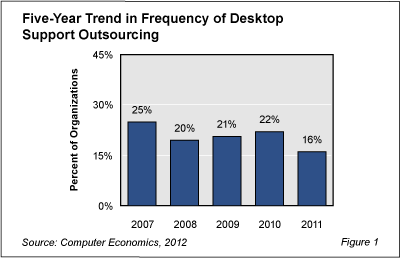The number of IT organizations outsourcing desktop support is continuing on its downward slope after stabilizing over the past three years.
Our study, Desktop Support Outsourcing Trends and Customer Experience, finds that 16% of organizations outsourced at least some of their desktop support work last year. That number is down from 22% in 2010 and 25% in 2007, as shown in Figure 1. From 2008 to 2010, the percentage of companies outsourcing desktop support remained relatively steady.

The reasons for the decline are varied. Recession-related cost-cutting is certainly involved: some organizations reduced service levels, brought work in-house, or responded to workforce reductions. A longer-term cause, however, is the deployment of strategies that increase the sophistication of the help desk. The use of remote tools is reducing the need for desk-side assistance. With many IT organizations upgrading help desk operations to handle more-complex issues and improve first-level resolution rates, support costs are migrating to the help desk. And as applications move into the cloud and to virtual desktops, more issues will require remote resolution.
The role of the desktop support technician is not diminishing, however. Desktop support technicians today commonly support local networks, phone systems, and printers, as well as in some cases smart boards, videoconferencing systems, and other systems in our technology-rich environments. The relationships that desktop support technicians form with users also can be instrumental in improving user satisfaction, and the presence of desktop support technicians in the field improves communications between users and the IT organization.
All of these factors can influence the decision to outsource this vital function. To help IT executives understand their options, the full study examines adoption trends in desktop support outsourcing. We assess desktop support outsourcing activity with four measures: frequency, level, net growth trend, and volatility. We also assess the customer experience as determined by our cost-success and service-success ratings. The report examines the five-year trend in desktop support outsourcing frequency and level and provides recommendations on desktop support outsourcing.
This Research Byte is a brief overview of our report on this subject, Desktop Support Outsourcing Trends and Customer Experience. The full report is available at no charge for Computer Economics clients, or it may be purchased by non-clients directly from our website (click for pricing).

